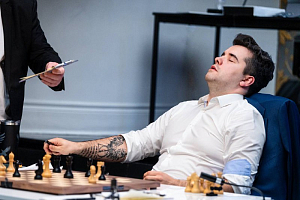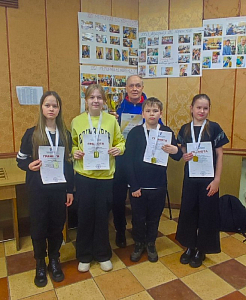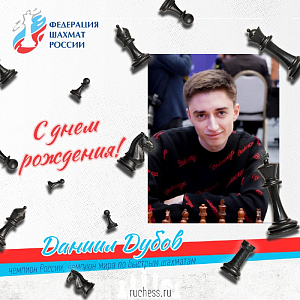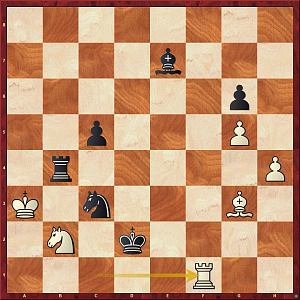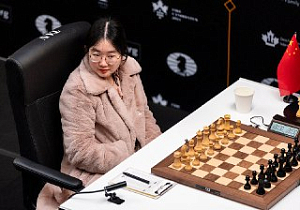21 May 2015
Exchange of knickknacks
Vladimir Barsky reports on the round 7 of the Grand Prix.
Two “Spanish tortures” in the Ruy Lopez ended badly for Black. Maxime Vachier-Lagrave extended his losing streak, however, in his case the opening did not play a major role. There were also three draws in this round, one of them being rather dull, but the other two being tense and exciting.
Jakovenko-Grischuk draw
Alexander Grischuk and Dmitry Jakovenko
A short draw in the Gruenfeld defense occurred in the game of two teammates and friends. Dmitry Jakovenko said at the press-conference: “For some reason I thought Sasha stopped playing the line with с6 and d5, and I did not repeat it before the game. The most principled line is 12.Qа4 Nb4. I thought for 15 minutes, but could not remember anything about it, and went for a drawing line I knew well.”
Alexander Grischuk explained that it was too dangerous for Black to avoid the move repetition. Being a poker pro, he estimated the chances with precision: “Black’s probability to lose was about 70%, which is far too risky.”
Let us add some more numbers. Four participants of the Khanty-Mansiysk tournament were born in 1983: Grischuk, Jakovenko, Baadur Jobava, and Lenier Dominguez. Two were born in 1987 – Hikaru Nakamura and Evgeny Tomashevsky, two – in 1990, Sergey Karjakin and Maxime Vachier-Lagrave. Boris Gelfand is the eldest player, he was born in 1968, Anish Giri is the youngest – 1994. Peter Svidler was born on 1976, and Fabiano Caruana – in 1992.
Nakamura-Vachier-Lagrave 1-0
The French grandmaster lost his fourth game in a row. Nakamura started the game in an original way: 1.d4 Nf6 2.Bf4!? Later he explained that he did not want to play anything theory heavy, and decided to give a try to this opening.
Hikaru Nakamura
Vachier-Lagrave replied that he was not too surprised, because Nakamura plays many openings. He added that considering his terrible form, this is probably the best strategy against him.
The Frenchman made several mistakes over the course of the game. He misplayed the opening and lost the right to castle, then blundered a fine knight leap 19.Nc5!, which helped Nakamura open attacking files. Finally, a pseudo-active move with the rook to d4 was very unfortunate: black pieces immediately got pinned, and Vachier-Lagrave had to resign.
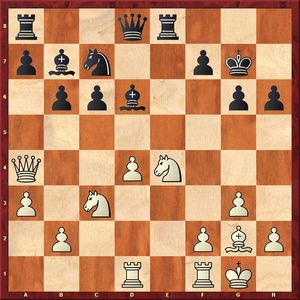
White is to play his 19th move
Karjakin-Jobava draw
Baadur Jobava decided against continuing an opening dispute in the Caro-Kann, which he plays in a rather original way, and went for the French Defense instead. However, in this opening he also selected an unpopular sideline – 3…Nc6. “I played this variation a few times and got decent results, but it does not mean this is a good move!” said Baadur. “Sergey selected the most principled line, which Saric played against me. I handled the opening badly in that game, but today showed an improvement.”
Baadur Jobava
Jobava also said that he found about the computer suggestion 10.Nh5 from one of the spectators after the game. Both grandmasters overlooked that opportunity. “If Sergey played this move, it would be very suspicious!” laughed Jobava. “But he made a human move, so now we all know that Karjakin is not a cheater.”
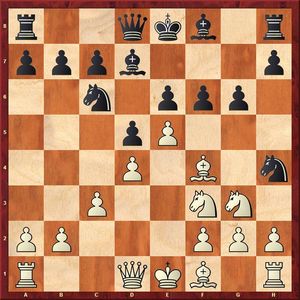
Here White has the stunning 10.Nh5
The game developed quite lively. Black sacrificed an exchange for strong initiative. Karjakin preferred to simplify the game, giving up a bishop for a couple of pawns, but forcing exchange of the queens. “Playing such a sharp position under the time pressure is very dangerous”, explained Sergey his decision.
In a dynamically balanced position the players began to repeat moves.
Caruana-Gelfand draw
At the press-conference Boris Gelfand reminded with a smile that he played this variation of the Gruenfeld against Anatoly Karpov even before his today’s opponent was born. Nevertheless, not all secrets of this variation are revealed yet. Lively piece play ensued, and it was hard to read when the grandmasters were out of books and began playing on their own.
Boris Gelfand and Fabiano Caruana
During the analysis Boris Gelfand quoted the legendary Andre Lilientahl: “This position has so many knickknacks!” Only deep home analysis can reveal whether White had real chances to get an advantage. In the actual game White and Black had an even number of knickknacks, and the peaceful outcome seems fair.
Dominguez-Svidler 1-0
“I would very much like to start playing White against Lenier”, opened Peter Svidler the press-conference. Since 2009 he regularly gets Black pieces against Lenier Dominguez in every tournament they play, and usually suffers in the opening.
Peter Svidler and Lenier Dominguez
Early in the game Svidler thought for a long time on his 9th move. “Finally I castled, got up from the board and saw this huge grin on Alexander Grischuk’s face, who told me I made his day. The moment he saw this position on the board, he thought: now Peter will think for half an hour, then he will play castles, and I will meet him muttering under his breath, cursing his life. And this is exactly what I did. Anyway, it is a theoretical position, and there is nothing special for White, but I really didn’t want to play it today.”
Black failed to achieve equality after the opening. Playing White was easier, as he could combine threats on both queenside and kingside. Black pieces were tied up protecting weaknesses on а6, b4 and е5.
Soon White opened up the kingside and started an attack, as black pieces were badly coordinated. Black could probably defend more accurately, but under the time pressure Svidler allowed the е5-е6 break, which sealed the game.
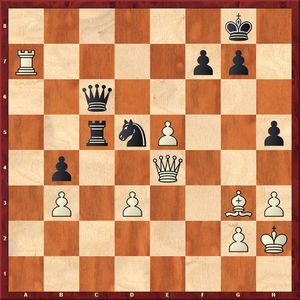
White is to play his 38th move
Giri-Tomashevsky 1-0
This was another Spanish torture, but Black suffered a lot longer. In the opening he voluntarily spoiled his pawn structure by taking the a4-pawn.
“This is a very interesting variation introduced by Evgeny”, commented Anish Giri. “It looks risky but is hard to refute. I analyzed it a lot, but Evgeny surely knows it better, although he will unlikely share his knowledge!”
“I played this line before, won a couple of games, so the discussion is open”, said Tomashevsky. “The main problem is not the opening, the main problem is that I am playing badly. Once again at this tournament I simply cannot explain some of my moves.”
Evgeny Tomashevsky and Anish Giri
White created pressure on the kingside and forced exchange of the light-squared bishops. After that Anish regained the a4 pawn, and Evgeny carried out the important d6-d5 break. The resulting position looked balanced, but Black played passively, allowing White to group and renew his kingside attack. Being under severe time trouble, Tomashevsky made a couple of inaccuracies, and White’s attack decided the game on the 58th move.
* * *
Standings after 7 rounds: 1. Caruana – 5, 2-3. Karjakin and Dominguez – both 4.5, 4-5. Svidler and Nakamura – both 4, 6-7. Gelfand and Jakovenko – both 3.5, 8-10. Grischuk, Jobava, and Giri – all 3, 11. Tomashevsky – 2.5, 12. Vachier-Lagrave – 1.5.












